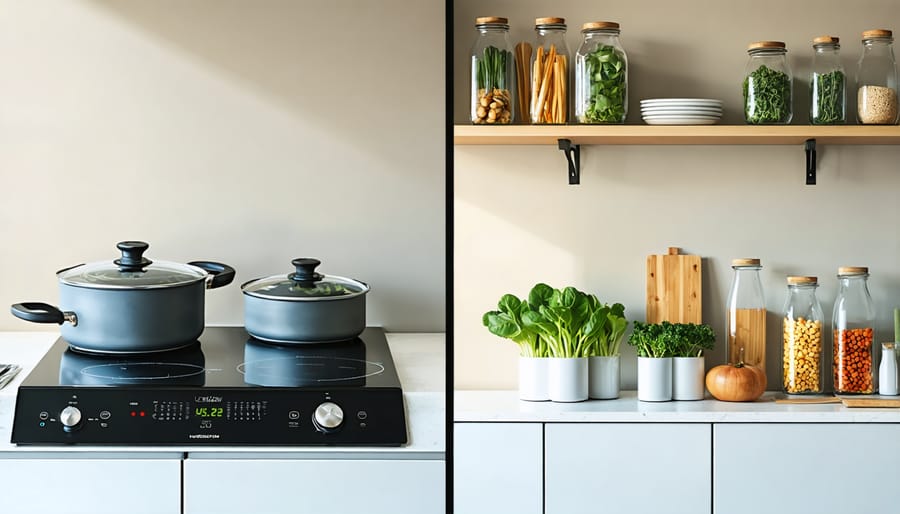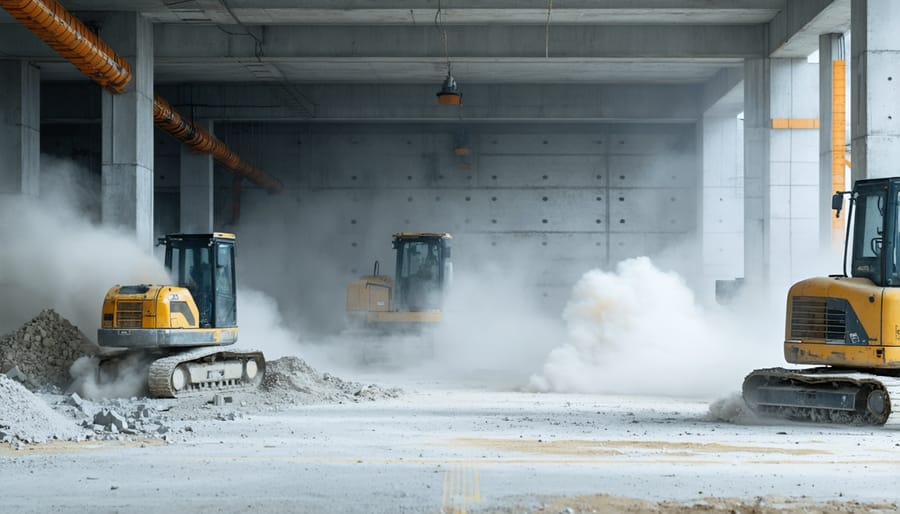Surviving a home renovation requires military-grade planning and ironclad patience, but it doesn’t have to break your spirit or the bank. Create a detailed timeline with built-in buffer zones for unexpected delays – most renovations take 30% longer than initially estimated. Set up a functional temporary living space before demolition begins, complete with a makeshift kitchen, bathroom essentials, and dedicated work-from-home area if needed. Establish clear communication channels with your contractor, including daily check-ins and a shared digital folder for permits, designs, and progress photos.
Living through dust, noise, and chaos isn’t just about physical endurance – it’s a mental marathon. Plan your renovation in phases to maintain at least one functional living space at all times. Store essential items in clearly labeled, easily accessible containers, and consider renting a storage unit for furniture and valuables. Keep a renovation journal to track progress, document decisions, and maintain your sanity through the process. Remember: successful renovations aren’t just about surviving – they’re about maintaining your quality of life while transforming your space into something extraordinary.
This process might feel overwhelming, but with proper preparation and realistic expectations, you can navigate your renovation journey without losing your mind or compromising your home’s future value.
Planning Your Eco-Friendly Renovation Timeline
Creating Living Zones
Living through a renovation doesn’t mean you have to exist in complete chaos. The key is creating distinct living zones that separate construction areas from your daily living spaces. Start by designating at least one “clean room” that’s completely off-limits to construction work – this will be your sanctuary during the project.
Use plastic sheeting and tape to seal off construction areas, preventing dust from infiltrating your living spaces. Consider setting up temporary cooking stations if your kitchen is under renovation, complete with a microwave, electric kettle, and mini-fridge. A folding table and chairs can create an instant dining area in any room.
If possible, establish separate entrances for construction crews and family members to minimize cross-traffic and dust transfer. Create clear pathways through your home that avoid construction zones, making daily navigation easier and safer. Don’t forget to designate clean storage areas for important items you’ll need regular access to.
For bedrooms affected by renovation, consider temporarily relocating to other rooms or creating makeshift sleeping areas in clean zones. Remember to keep essential items easily accessible and organize them in clearly labeled containers.
Sustainable Material Lead Times
When planning your eco-friendly renovation, understanding lead times for sustainable material choices is crucial for keeping your project on track. Many environmentally conscious materials can take longer to source than conventional options, so it’s essential to plan ahead.
Reclaimed wood, for instance, typically requires 4-8 weeks for proper sourcing and preparation, while bamboo flooring might need 3-6 weeks for delivery and acclimation. Recycled glass countertops often have a 6-10 week lead time due to custom fabrication processes, and sustainable cork flooring usually needs to be ordered 4-6 weeks in advance.
Start researching and ordering materials at least three months before your intended renovation start date. Create a detailed timeline spreadsheet that includes ordering dates, expected delivery windows, and installation schedules. Remember to factor in additional time for potential delays, especially with custom-made eco-friendly items or materials sourced from smaller, sustainable manufacturers.
Pro tip: Always order about 10-15% more material than needed to account for cuts, waste, and potential future repairs while ensuring you maintain consistent batch numbers for materials like tiles or flooring.
Setting Up a Temporary Living Space
Portable Kitchen Solutions
Setting up an eco-friendly temporary kitchen setup doesn’t have to be complicated or energy-draining. Start with a portable induction cooktop, which uses 90% less energy than traditional electric stoves while providing excellent cooking control. Pair it with a countertop convection oven that can handle multiple cooking tasks efficiently.
For food storage, invest in an Energy Star-rated mini fridge, which offers ample space for essentials while consuming minimal power. Consider a solar-powered cooler for additional storage – perfect for beverages and less-frequently used items.
Create a dedicated prep station using a folding table and organize your essential cooking tools in clear, stackable containers. A camping sink with a water-efficient faucet attachment can serve as your washing station, helping conserve water during the renovation.
Smart meal planning is crucial: prep ingredients in batch cooking sessions and utilize energy-efficient appliances like slow cookers and electric pressure cookers. These not only save power but also reduce cooking time and heat generation in your temporary space.
Remember to keep frequently used items within easy reach and store rarely used equipment in clearly labeled boxes. This organized approach will help maintain your cooking routine while minimizing energy waste and frustration during the renovation period.

Bathroom Access Planning
One of the most crucial aspects of surviving a home renovation is planning for bathroom access. If you’re renovating your only bathroom, create a temporary solution before work begins. Consider renting a portable toilet for outdoor access, or if possible, arrange to use a neighbor’s facilities during crucial phases of the work. For longer renovations, installing a temporary shower in the basement or garage can be a practical solution.
When renovating multiple bathrooms, tackle one at a time to maintain access to at least one functioning facility. Work with your contractor to establish a realistic timeline for each bathroom renovation, ensuring minimal disruption to your daily routine. If you’re installing water-efficient fixtures, plan the installation sequence to avoid being completely without facilities.
Keep essential toiletries organized in a portable caddy for easy transport, especially if you’re using temporary facilities or a neighbor’s bathroom. Install a temporary sink in the laundry room or kitchen for basic hygiene needs. Remember to maintain a supply of hand sanitizer and wet wipes for times when water access might be limited.
For families with young children or elderly members, consider staying with relatives during the most disruptive phases of bathroom renovation to ensure comfort and safety.
Protecting Your Health and Environment
Dust Control Strategies
Construction dust is one of the biggest challenges during home renovation, but there are several effective ways to keep it under control. Start by creating dust barriers using plastic sheeting from floor to ceiling, securing them tightly with painter’s tape. Place damp towels at the bottom of doors to prevent dust from seeping under them.
Invest in a HEPA air purifier and run it continuously in rooms adjacent to the construction area. For natural dust control, place bowls of water around the renovation space – they’ll help capture airborne particles. Dampen the work area slightly before starting each day’s work, as this helps prevent dust from becoming airborne.
Keep your HVAC system from spreading dust by sealing off vents in the construction zone and changing your air filters more frequently during renovation. Consider using a shop vacuum with HEPA filtration for daily cleanup rather than sweeping, which can stir up more dust.
Work with your contractors to implement dust-minimizing techniques like using tools with dust collection systems and cutting materials outdoors when possible. Remember to wipe down surfaces daily with a damp microfiber cloth to prevent dust buildup.

Air Quality Management
During renovation, maintaining healthy air quality is crucial for your well-being. Start by setting up natural ventilation systems using strategically placed fans near windows to create cross-ventilation. Open windows during work hours when weather permits, but be sure to close them during heavy dust-generating activities.
Consider investing in HEPA air purifiers, placing them in your living spaces away from the renovation area. These machines effectively capture dust, allergens, and other airborne particles. For a natural approach, add air-purifying plants like spider plants or peace lilies to your temporary living space.
Create dust barriers using plastic sheeting and painter’s tape to seal off renovation areas. Use eco-friendly cleaning methods like damp mopping instead of sweeping, which can stir up particles. Keep a spray bottle with water handy to mist the air and settle dust when needed.
Don’t forget about your HVAC system – close vents in renovation areas and change filters more frequently during the project. Consider using natural air fresheners like essential oils or simmering citrus peels instead of chemical-based products to keep your space fresh without adding harmful compounds to the air.
Managing Daily Life During Renovation
Work-from-Home Solutions
When renovation chaos takes over your home, creating a functional workspace becomes crucial for your productivity and sanity. Start by identifying a quiet corner away from the main construction area – this could be a spare bedroom, finished basement, or even a converted closet. Consider sustainable home office solutions like portable LED desk lamps and energy-efficient laptop stands to minimize your environmental impact while maintaining comfort.
Set up noise-canceling barriers using thick curtains or temporary partition walls. A folding screen can work wonders in creating a visual boundary between your workspace and renovation zones. Keep essential office supplies organized in portable containers that you can easily relocate if construction needs shift.
Ensure reliable internet connectivity by using a mobile hotspot as backup, and invest in a good pair of noise-canceling headphones. Position your temporary desk near natural light sources to reduce energy consumption and boost your mood. Consider using a portable air purifier to maintain good air quality, especially important during dusty renovation work.
Remember to establish clear boundaries with contractors about your work hours and communicate your needs regarding noise levels during important virtual meetings. With proper planning, you can maintain productivity without compromising your work quality or comfort.

Storage and Organization
During renovation, smart storage solutions become your best friend, and there’s no need to compromise on eco-friendliness. Start by sorting your belongings into three categories: daily essentials, occasionally needed items, and rarely used stuff. Consider renting reusable plastic moving boxes instead of buying cardboard ones – they’re more durable and can be used multiple times by others after you’re done.
Create designated zones in your livable spaces using sustainable bamboo organizers or repurposed furniture. Clear plastic containers with secure lids are perfect for protecting items from dust while letting you see what’s inside, reducing the need to open multiple boxes. Label everything meticulously using biodegradable tape or recyclable stickers.
Make use of vertical space by installing temporary shelving units made from reclaimed wood or borrowing portable wardrobes. Vacuum-seal bags are fantastic for compressing soft items like bedding and clothing, maximizing space while protecting them from moisture and debris.
Don’t forget to create a “renovation survival kit” containing daily necessities, keeping it easily accessible. For documents and valuable items, consider using digital storage solutions when possible to reduce paper waste. Remember, good organization during renovation isn’t just about surviving – it’s about maintaining your sanity while staying true to your environmental values.
Maintaining Your Sanity
Creating Green Escape Spaces
During the chaos of renovation, creating a peaceful retreat can help maintain your sanity. Start by designating one room or area as your green escape space – ideally somewhere away from the construction zone. Fill this space with potted plants like peace lilies, snake plants, or pothos, which naturally purify the air and create a calming atmosphere.
Layer your sanctuary with natural elements: add a small indoor fountain for soothing water sounds, use bamboo blinds for filtered natural light, and incorporate organic materials like wooden furniture or jute rugs. Place comfortable seating with soft, natural-fiber cushions to create a cozy spot for relaxation.
Consider adding a small herb garden to your escape space – the fresh scents of basil, mint, or lavender can help reduce stress. Use recycled containers or sustainable planters to maintain eco-friendly practices. Keep this area dust-free by covering plants during heavy construction periods and regularly wiping leaves with a damp cloth.
This green oasis will not only provide mental relief during renovation but also inspire design ideas for your renewed living space.
Managing Contractor Relations
Clear communication is the cornerstone of successful renovation projects. Start by establishing preferred communication channels with your contractor – whether it’s email, text, or scheduled calls – and stick to them. Create a shared digital folder for important documents, permits, and progress photos to keep everyone aligned.
Schedule regular check-ins with your contractor, ideally at the same time each week. During these meetings, discuss timeline updates, upcoming decisions, and any concerns before they become issues. Always put major decisions and changes in writing, even if they’re initially discussed verbally.
When challenges arise, remain professional and solution-focused. Express concerns clearly but constructively, using specific examples rather than general complaints. Remember that sustainable building practices might require extra explanation or coordination, so maintain patience during these discussions.
Keep a renovation journal documenting all conversations and decisions. This helps prevent misunderstandings and provides a valuable reference point if questions arise later. Finally, while maintaining professional boundaries, building a positive working relationship with your contractor can lead to better results and a smoother renovation experience.
Surviving a home renovation is no small feat, but with the right mindset and strategies, you can emerge from the experience stronger and with a beautiful, sustainable living space to show for it. Remember that proper planning is your strongest ally – from creating detailed timelines to establishing clear communication channels with your contractors and setting realistic expectations for yourself and your family.
Stay flexible and maintain perspective throughout the process. Unexpected challenges are part of any renovation journey, but they’re temporary inconveniences on the path to your dream home. Focus on the end goal while taking care of your well-being during the process. Whether it’s setting up a functional temporary kitchen, creating dust-free zones, or maintaining some semblance of normal routine, these survival strategies will help you navigate the renovation maze.
Don’t forget that sustainable choices during renovation not only benefit the environment but often lead to long-term savings and increased home value. By carefully selecting eco-friendly materials, planning for energy efficiency, and properly disposing of waste, you’re contributing to a better future while creating your ideal living space.
Most importantly, celebrate small victories along the way. Each completed phase brings you closer to your goal. With patience, preparation, and persistence, you’ll successfully weather the renovation storm and create a home that’s not just beautiful but also sustainable and truly yours.
